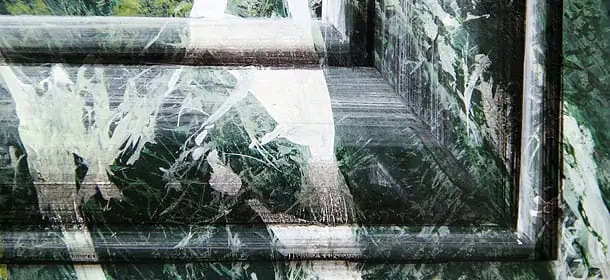

The Art League Blog is taking a trip down memory lane and reposting some of our most popular art resources! Please enjoy this newly updated post from the vault, originally published December 16, 2016.
If you love art, you’ve surely come across the term trompe l’oeil. It’s often defined simply by explaining that the words are French for “fool the eye,” but that doesn’t really tell the whole story.
Here’s how trompe l’oeil works, and some of our favorite examples:
Both trompe l’oeil and photorealism both involve depicting something as realistically as possible, but there are a few differences:

So, the above drawing by Wendy Donahoe could be described as photorealistic, but not trompe l’oeil. For one, because it’s monochrome, it doesn’t try to fool the eye the way a drawing or painting in color could. The composition is that of a classic portrait, as well: the figure is posing within the frame, not attempting to climb out of it.
There are many tricks and techniques painters can use to fool the viewer.

Art League instructor Patrick Kirwin shows how he uses things like a turkey feather and plastic bag to paint marble in these videos. (Kirwin is known for painting murals, a common setting for trompe l’oeil because there’s no frame to give away the illusion.)
Dennis Crayon, a 2016 solo artist at The Art League, explained some of his process in our 2013 Q&A interview. He starts with a photograph and plans out the composition in Photoshop before starting the painting.

Regardless of the approach, a smooth surface is an essential starting point. Crayon paints and sands many layers of gesso (a white, paint-like material) onto his panels before he starts painting.
An artist can take the illusion as far as they wish, even extending to the frame, or in this artwork’s case, the signature:

Trompe l’oeil isn’t limited to painting, either.

In Wendell Castle’s famous Ghost Clock sculpture, what appears to be a clock draped in cloth is in fact a single piece of wood, partially bleached to complete the illusion.
In other settings, trompe l’oeil can provoke a stronger reaction. For example, these life-size security guard sculptures can make museum visitors jump. And you’ve probably seen photos of crowd-gathering trompe l’oeil sidewalk chalk artworks. Instead of popping out from the wall, these illusions rise up out of the ground, and they need to be viewed from just the right angle.

Now that you’ve learned what trompe l’oeil means, maybe you’d like to give it a try!
Patrick Kirwin teaches Trompe L’oeil and Photorealism four times a year at The Art League. For all our painting classes and more, you can browse our catalog online!
Sign up for our weekly blog newsletter, subscribe to our RSS feed, or like us on Facebook for the latest Art League news. Visit our homepage for more information about our classes, exhibits, and events in Old Town Alexandria, Virginia.
You can support The Art League every time you shop through AmazonSmile!
Simply set The Art League as your chosen charity, and every time you shop at smile.amazon.com, a portion of your purchase will be donated to support our mission to share the experience of visual arts with the community.